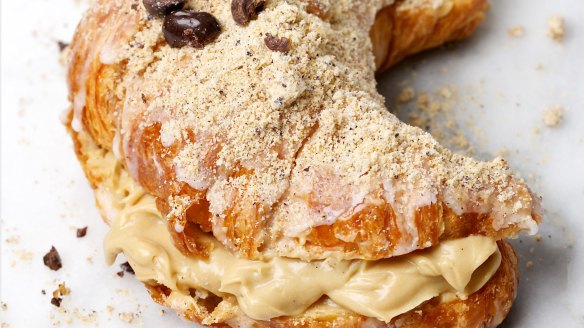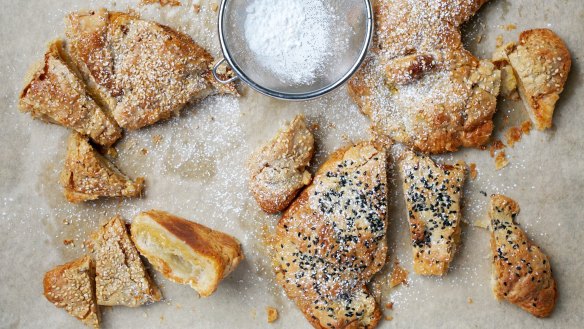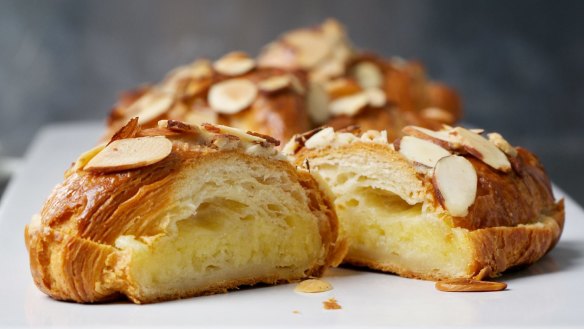Three ways to pimp a bakery-bought croissant

"In France, people don't idolise croissants," says cookbook author David Lebovitz, who worked in the pastry department at Californian restaurant Chez Panisse before moving to Paris in 2004. "People don't rhapsodise about them ... They're just a part of life. It's an everyday food." The same is true of almond croissants, although he does admit that, "because they're sort of leftovers, they don't necessarily have the same esteem." But they are no less loved.
French patisseries were able to economically transform their scraps into what became an icon in its own right by soaking the unsold day-old pastry in a sweet syrup, filling – and topping – it with frangipane, a paste made of almond meal, sugar, butter and eggs, then baking it.
Becky Quan, pastry chef at the soon-to-open NoMad restaurant in Las Vegas, does a proper almond croissant that's made according to French protocol. But she likes having the freedom to play around, to change the fillings and introduce glazes and garnishes. She builds on base recipes for pastry cream, glaze and crumb topping that can be altered to introduce a new creation each week. For example, there's a croissant that's "just hazelnut on hazelnut," Quan says. "It has hazelnut pastry cream with Nutella glaze and a hazelnut crumble."
What makes these different from other constructions is that they start with a freshly baked croissant. This lends them to amateur undertakings, although you could say the same of the old-fashioned approach, which also calls for pre-baked pastry. Either way, you can skip the part where you make croissants from scratch and still impress loved ones, and yourself, by doctoring a store-bought entity.
But don't settle for someone else's crummy crescents. As in all endeavours, starting with the best ingredients yields the best results. Per Leong: "Avoid using an underbaked croissant; when you eat it, it will be gummy." Your almond croissant "should be moist inside and well covered on top." But you don't want too much almond cream up there, or you're left with a soggy, flattened pancake of a thing. "You want just enough almond cream so when you bite it, it's a little soft and a little crunchy."
Lebovitz says "soaking it in enough syrup is important for the almond croissant." So is baking it enough, and using enough filling, he says. "When the filling runs out and kind of burns, like grilled cheese; those are the good parts."
They are my favourite parts. Some pastry chefs disagree, preferring neater, prettier products without any oozy over-spill.
Decide for yourself when you try Lebovitz's recipe for croissants aux amandes the old-fashioned way, or my even lower-maintenance sesame variation. For a taste of Quan's elaborate creations, make her coffee pastry cream and/or her coffee crumble.
Coffee pastry cream
This is the filling for the coffee croissants that pastry chef Becky Quan makes for NoMad - just one of several components (including her coffee crumble recipe below) that include a syrup, glaze and crushed coffee beans.
It's fairly simple to re-create a streamlined version of her croissants; you could split a fresh bakery croissant and brush it with syrup (see croissants aux amandes recipe below), bake and fill.
The pastry cream could be flavoured with jam, peanut butter, Nutella or matcha powder instead of coffee. You could fold in small pieces of fruit or cookie crumbs.
Make ahead: You will have about a cup of pastry cream left over, which can be refrigerated in an airtight container for up to 5 days.
INGREDIENTS
2 cups milk
scrapings from 1 vanilla bean, plus the pod
½ cup plus 3 tsp castor sugar
¼ cup plus 1½ tbsp cornflour
¼ tsp salt
6 large egg yolks
6 tbsp cold unsalted butter, cut into cubes
1 tbsp coffee extract (may substitute strongly brewed, then cooled, espresso coffee)
METHOD
Heat the milk in a medium saucepan over medium heat. Add the vanilla bean scrapings and the pod. Remove the pot from the heat, cover it, and let the mixture cool and infuse for 20 minutes. Discard the pod and stir the milk to distribute the vanilla evenly.
Meanwhile, combine the sugar, cornflour and salt in a medium bowl.
Place the egg yolks in a separate, larger bowl. Whisk in the sugar-cornflour mixture until smooth and thoroughly incorporated. The mixture should be fluffy and pale.
Whisk a small amount of the still-warm, vanilla-infused milk into the egg yolk mixture; this is called tempering. Then, whisk that mixture into the saucepan of vanilla-infused milk. Place over medium heat; cook, whisking constantly, to form a thickened custard. A trail left by the whisk should hold.
Transfer to a large bowl; gradually add the cubes of cold butter to the custard, whisking constantly, until they are completely emulsified and the custard is glossy (this is your pastry cream).
Whisk in the coffee extract until well incorporated. Place a layer of plastic wrap directly on the surface of the cream. Refrigerate until well chilled before using.
Makes 3 cups
Coffee crumble
Pastry chef Becky Quan created this topping to adorn her filled croissants, but we have found it has multiple applications, including the tops of banana bread, and on ice-cream, yoghurt and parfaits.
Make ahead: The crumble can be stored in an airtight container at room temperature for up to 3 days.
INGREDIENTS
½ cup plus 3 tsp light brown sugar
1 cup flour
3 tbsp unsalted butter, at room temperature
¼ tsp salt
1½ tbsp instant espresso powder
METHOD
Preheat the oven to 160C. Line a rimmed baking tray with baking paper.
Combine the brown sugar, flour and butter in the bowl of a stand mixer or handheld electric mixer; beat on low speed until blended, then add the salt and espresso powder. Increase the speed to medium, beating to form a coarse, crumbly mixture.
Spread the mixture out on the prepared baking sheet, using your hands to break up any remaining larger bits. Bake (middle rack) for 20 to 30 minutes total, rotating the pan and stirring the crumbs halfway through. Cool on the baking sheet.
Once the mixture is cool enough to handle, use your hands or a fork to break it up into crumbly chunks.
Makes enough for 8 croissants
Recipe adapted from pastry chef Becky Quan.

Sesame croissants
Traditional frangipane is made with almond meal, sugar, butter and egg (see Frank Camorra's recipe). The first three ingredients form a paste that the egg binds together. Sesame halva is not unlike that paste; beat it with an egg, and you get something that behaves a lot like frangipane.
INGREDIENTS
For the filling
1 large egg
⅛ tsp salt
225g best-quality halva, crumbled
For the croissants
½ cup water
¼ cup castor sugar
1½ tbsp dark rum, amaretto or kirsch (optional)
4 croissants, preferably day-old (on the large side)
3 tsp sesame seeds
icing sugar, for dusting (optional)
METHOD
For the filling Use a whisk to lightly beat the egg and salt in a mixing bowl. Add the halvah, bit by bit, whisking, until a thick paste-like spread forms.
For the croissants Bring the water and castor sugar to a boil in a small saucepan over medium-high heat, stirring just until the sugar has dissolved. Remove from the heat, then stir the alcohol, if using.
Starting at one side, use a serrated knife to cut each croissant in half horizontally, stopping just before you reach the other side, leaving that part uncut (as a hinge). Brush the inside of each croissant liberally with the syrup on both sides, making sure each side is completely saturated; use more syrup than you think is necessary. It might seem like a lot, but the finished croissants benefit from the moisture.
Smear the inside of each croissant with 1½ tablespoons of the filling, arranging the croissants on the baking tray as you work. Press each one down firmly. Divide the remaining filling over the top of each croissant and smear it over the top. Sprinkle some of the sesame seeds over each croissant, then bake in a 190C oven for about 15 minutes, until the tops are golden brown.
Cool for a few minutes, then sprinkle each filled sesame croissant with icing sugar, if desired.
Makes 4

Croissants aux amandes
Cookbook author David Lebovitz's advice: Don't be stingy when applying the frangipane and the syrup. Double the amount of each when you are dealing with large croissants. Shove chocolate chips, small pieces of banana or dried sour cherries in with the almond paste. Note: the frangipane mixture can be beaten by hand.
Make ahead: The almond-filled croissants are best served the same day they are made, either warm or at room temperature, but they can be kept in an airtight container overnight. Leftover frangipane can be used to line fruit tarts, and you can make it with hazelnuts (skip the almond extract, and try Frangelico in the syrup) or pistachios. The frangipane can be refrigerated in an airtight container for up to 1 week or frozen for up to 2 weeks.
INGREDIENTS
For the frangipane
1/2 cup almond meal
1/4 cup castor sugar
1 large egg, at room temperature
2½ tbsp unsalted butter, at room temperature
a few drops pure almond extract
pinch salt
For the croissants
½ cup water
¼ cup castor sugar
1½ tbsp dark rum, amaretto or kirsch (optional)
4 croissants, preferably day-old
3 to 4½ tbsp flaked almonds
icing sugar, for dusting (optional)
METHOD
For the frangipane: Combine the almond meal, castor sugar, egg, butter, almond extract and salt in the bowl of a stand mixer or handheld electric mixer; beat on low speed until incorporated, then increase the speed to high and beat for 3 minutes, or until light and fluffy.
For the croissants: Preheat the oven to 190C. Line a baking tray with baking paper or a silicone liner.
Bring the water and granulated sugar to a boil in a small saucepan over medium-high heat, stirring just until the sugar has dissolved. Remove from the heat, then stir the liquor, if using.
Starting at one side, use a serrated knife to cut each croissant in half horizontally, stopping just before you reach the other side, leaving that part uncut (as a hinge). Brush the inside of each croissant liberally with the syrup on both sides, making sure each side is completely saturated; use more syrup than you think is necessary. It might seem like a lot, but the finished croissants benefit from the moisture.
Smear the inside of each croissant with 1½ tablespoons of the frangipane, arranging the croissants on the baking sheet as you work. Press each one down firmly. Divide the remaining frangipane over the top of each croissant and smear it over the top. Sprinkle each croissant with 3 teaspoons of the sliced almonds, then bake (middle rack) for about 15 minutes, until the tops are golden brown.
Let cool for a few minutes, then sprinkle each filled almond croissant with icing sugar.
Makes 4-6 (depending on the croissants' size)
Recipe from cookbook author David Lebovitz
The Washington Post
The best recipes from Australia's leading chefs straight to your inbox.
Sign up- More:
- How to